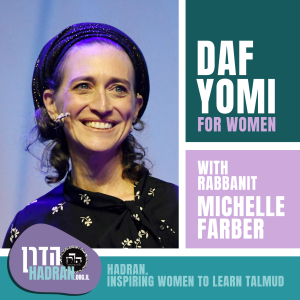
Study Guide Megillah 9
Today’s daf is sponsored by Suri Stern in loving memory of her father Ruby Davis, Harav Reuvain ben Harav Chaim. “He was the first gabbai in the White Shul in Far Rockaway and completed Shas many times over and transmitted his ahvavat habriyot to his family.”
Can holy books be written in any language? According to the Mishna they can be, however tefillin and mezuzot can only be written in Ashurit script. Rabban Shimon ben Gamliel says that holy books can only be written in Greek. The Gemara infers that all these things make one’s hands impure (according to a rabbinic decree) and all are sewn with animal sinews. A contradiction to our Mishna is brought from a braita that states that holy books must be written in Ashurit script as well. Five answers are brought to resolve the contradiction. Questions are raised against each of the answers. Rabbi Yehuda explains Rabban Shimon ben Gamliel’s opinion about Greek to be relating only to the Torah and because of the story of Ptolemy who took 72 elders and told them to translate the Torah into Greek. According to the story, each one of them was placed in a separate room and yet each of them translated in the exact same way. Regarding some verses, they each deliberately distorted certain passages in order to protect the integrity of the Jewish faith. From where can one derive from the Torah that it can be translated into Greek? A Kohen Gadol who is anointed with the special oil is different from one who was not anointed but became a Kohen Gadol by wearing the Kohen Gadol’s eight garments in that only he can bring a communal sin offering. A Kohen Gadol who is no longer a Kohen Gadol differs from a regular Kohen Gadol only in that he doesn’t perform the Yom Kippur service and doesn’t bring the daily mincha offering that the Kohen Gadol brings. Some disagree and say that even one who becomes a Kohen Gadol from wearing the garments can bring a communal sin offering. Rabbi Yosi disagrees with the end of the Mishna and holds that one who is no longer a Kohen Gadol can no longer work in The temple. What offerings could be brought on a small individual bama, a place meant for bringing sacrifices) and which ones could be brought on a large bama? Which were not able to be brought on a bama at all. What are the differences between the Tabernacle in Shilo and the Temple in Jerusalem?
More Episodes
 2024-03-26
2024-03-26
 2024-03-24
2024-03-24
 2024-03-22
2024-03-22
 2024-03-22
2024-03-22
 2024-03-21
2024-03-21
 2024-03-20
2024-03-20
 2024-03-19
2024-03-19
 2024-03-18
2024-03-18
 2024-03-17
2024-03-17
 2024-03-15
2024-03-15
 2024-03-15
2024-03-15
 2024-03-14
2024-03-14
 2024-03-13
2024-03-13
 2024-03-12
2024-03-12
 2024-03-08
2024-03-08
 2024-03-08
2024-03-08
 2024-03-07
2024-03-07
Create your
podcast in
minutes
- Full-featured podcast site
- Unlimited storage and bandwidth
- Comprehensive podcast stats
- Distribute to Apple Podcasts, Spotify, and more
- Make money with your podcast
It is Free
- Privacy Policy
- Cookie Policy
- Terms of Use
- Consent Preferences
- Copyright © 2015-2024 Podbean.com





